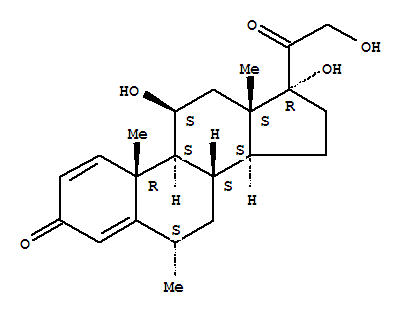|
Name:
|
6-alpha-Methylprednisolone 99% Material Safety Data Sheet
|
|
Synonym:
|
Medro
|
|
CAS:
|
83-43-2
|
Section 1 - Chemical Product
MSDS Name:6-alpha-Methylprednisolone 99% Material Safety Data Sheet
Synonym:Medro
Section 2 - COMPOSITION, INFORMATION ON INGREDIENTS
|
CAS#
|
Chemical Name
|
content
|
EINECS#
|
|
83-43-2
|
6-alpha-Methylprednisolone
|
99%
|
201-476-4
|
Hazard Symbols: XN
Risk Phrases: 40
Section 3 - HAZARDS IDENTIFICATION
EMERGENCY OVERVIEW
Limited evidence of a carcinogenic effect.
Potential Health Effects
Eye:
May cause eye irritation.
Skin:
Harmful if absorbed through the skin.
Ingestion:
Harmful if swallowed.
Inhalation:
Harmful if inhaled. May cause irritation of the respiratory tract with burning pain in the nose and throat, coughing, wheezing, shortness of breath and pulmonary edema.
Chronic:
Not available.
Section 4 - FIRST AID MEASURES
Eyes: Flush eyes with plenty of water for at least 15 minutes, occasionally lifting the upper and lower eyelids. Get medical aid.
Skin:
Get medical aid. Flush skin with plenty of water for at least 15 minutes while removing contaminated clothing and shoes.
Ingestion:
Get medical aid. Wash mouth out with water.
Inhalation:
Remove from exposure and move to fresh air immediately. If not breathing, give artificial respiration. If breathing is difficult, give oxygen. Get medical aid.
Notes to Physician:
Section 5 - FIRE FIGHTING MEASURES
General Information:
As in any fire, wear a self-contained breathing apparatus in pressure-demand, MSHA/NIOSH (approved or equivalent), and full protective gear.
Extinguishing Media:
Use foam, dry chemical, or carbon dioxide.
Section 6 - ACCIDENTAL RELEASE MEASURES
General Information: Use proper personal protective equipment as indicated in Section 8.
Spills/Leaks:
Vacuum or sweep up material and place into a suitable disposal container.
Section 7 - HANDLING and STORAGE
Handling:
Avoid breathing dust, vapor, mist, or gas. Avoid contact with skin and eyes.
Storage:
Store in a cool, dry place. Store in a tightly closed container.
Section 8 - EXPOSURE CONTROLS, PERSONAL PROTECTION
Engineering Controls:
Use adequate ventilation to keep airborne concentrations low.
Exposure Limits CAS# 83-43-2: Personal Protective Equipment Eyes: Not available.
Skin:
Wear appropriate protective gloves to prevent skin exposure.
Clothing:
Wear appropriate protective clothing to prevent skin exposure.
Respirators:
Follow the OSHA respirator regulations found in 29 CFR 1910.134 or European Standard EN 149. Use a NIOSH/MSHA or European Standard EN 149 approved respirator if exposure limits are exceeded or if irritation or other symptoms are experienced.
Section 9 - PHYSICAL AND CHEMICAL PROPERTIES
Physical State: Powder
Color: white
Odor: Not available.
pH: Not available.
Vapor Pressure: Not available.
Viscosity: Not available.
Boiling Point: Not available.
Freezing/Melting Point: 227-231 deg C
Autoignition Temperature: Not available.
Flash Point: Not available.
Explosion Limits, lower: Not available.
Explosion Limits, upper: Not available.
Decomposition Temperature:
Solubility in water: Insoluble.
Specific Gravity/Density:
Molecular Formula: C22H30O5
Molecular Weight: 374.207
Section 10 - STABILITY AND REACTIVITY
Chemical Stability:
Stable.
Conditions to Avoid:
Incompatible materials.
Incompatibilities with Other Materials:
Strong oxidizing agents, acids, acid chlorides, carbon dioxide, acid anhydrides.
Hazardous Decomposition Products:
Nitrogen oxides, carbon monoxide, carbon dioxide.
Hazardous Polymerization: Will not occur.
Section 11 - TOXICOLOGICAL INFORMATION
RTECS#:
CAS# 83-43-2: TU4146000 LD50/LC50:
CAS# 83-43-2: Oral, rat: LD50 = >4 gm/kg.
Carcinogenicity:
6-alpha-Methylprednisolone - Not listed by ACGIH, IARC, or NTP.
Other:
See actual entry in RTECS for complete information.
Section 12 - ECOLOGICAL INFORMATION
Section 13 - DISPOSAL CONSIDERATIONS
Dispose of in a manner consistent with federal, state, and local regulations.
Section 14 - TRANSPORT INFORMATION
IATA
No information available.
IMO
No information available.
RID/ADR
No information available.
Section 15 - REGULATORY INFORMATION
European/International Regulations
European Labeling in Accordance with EC Directives
Hazard Symbols: XN
Risk Phrases:
R 40 Limited evidence of a carcinogenic effect.
Safety Phrases:
S 36/37 Wear suitable protective clothing and
gloves.
S 45 In case of accident or if you feel unwell, seek
medical advice immediately (show the label where
possible).
WGK (Water Danger/Protection)
CAS# 83-43-2: No information available.
Canada
CAS# 83-43-2 is listed on Canada's NDSL List.
CAS# 83-43-2 is not listed on Canada's Ingredient Disclosure List.
US FEDERAL
TSCA
CAS# 83-43-2 is listed on the TSCA inventory.
SECTION 16 - ADDITIONAL INFORMATION N/A
